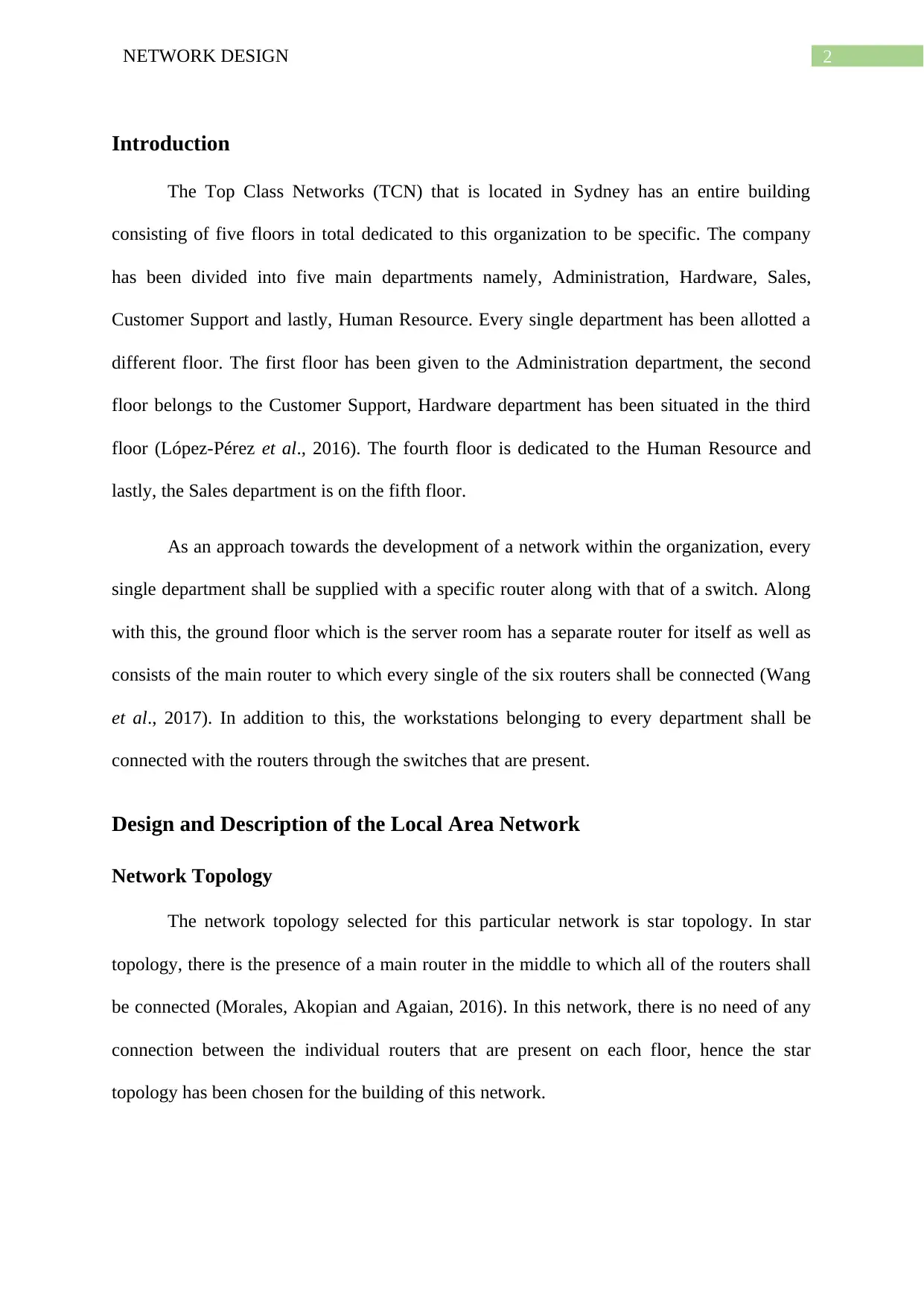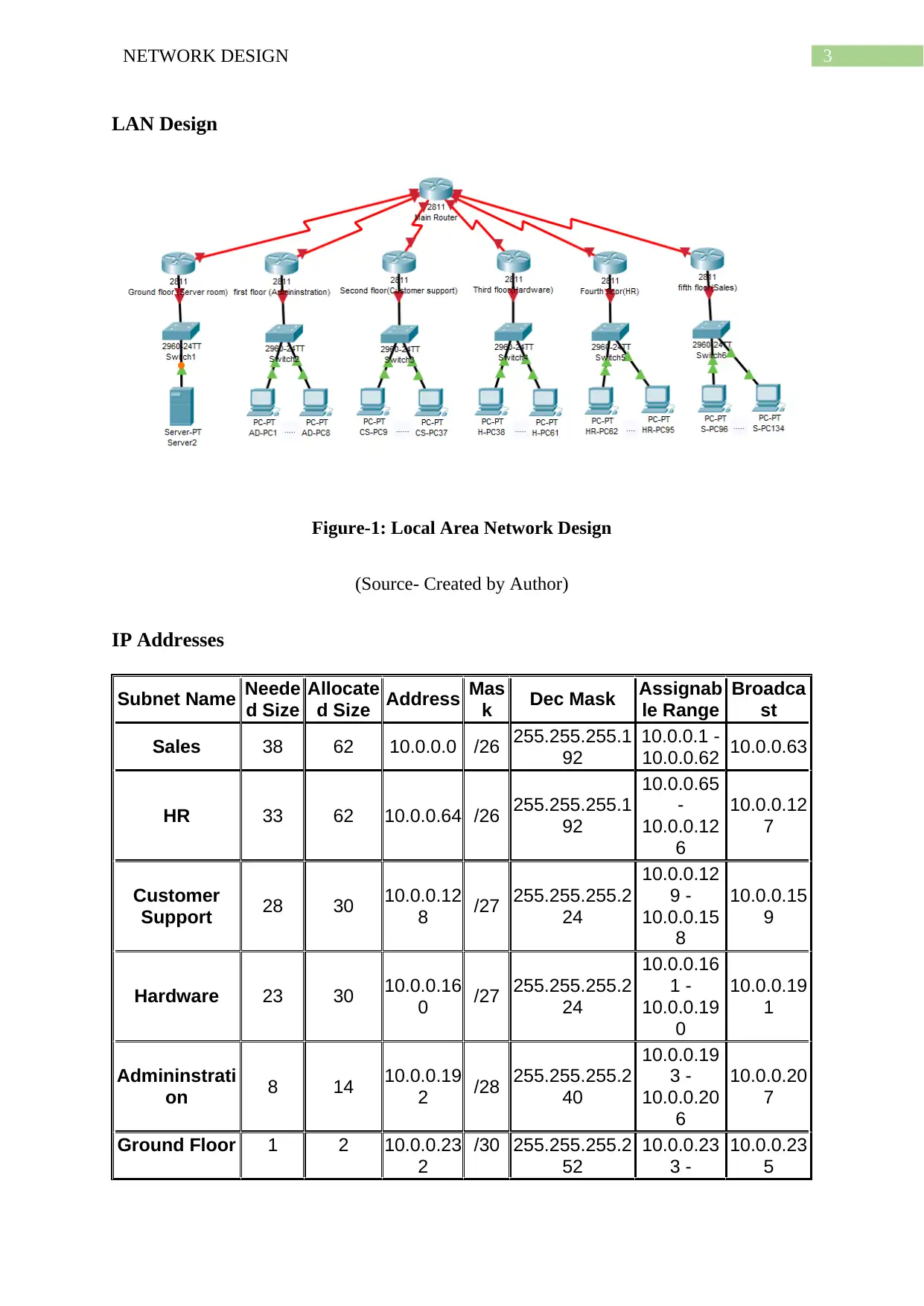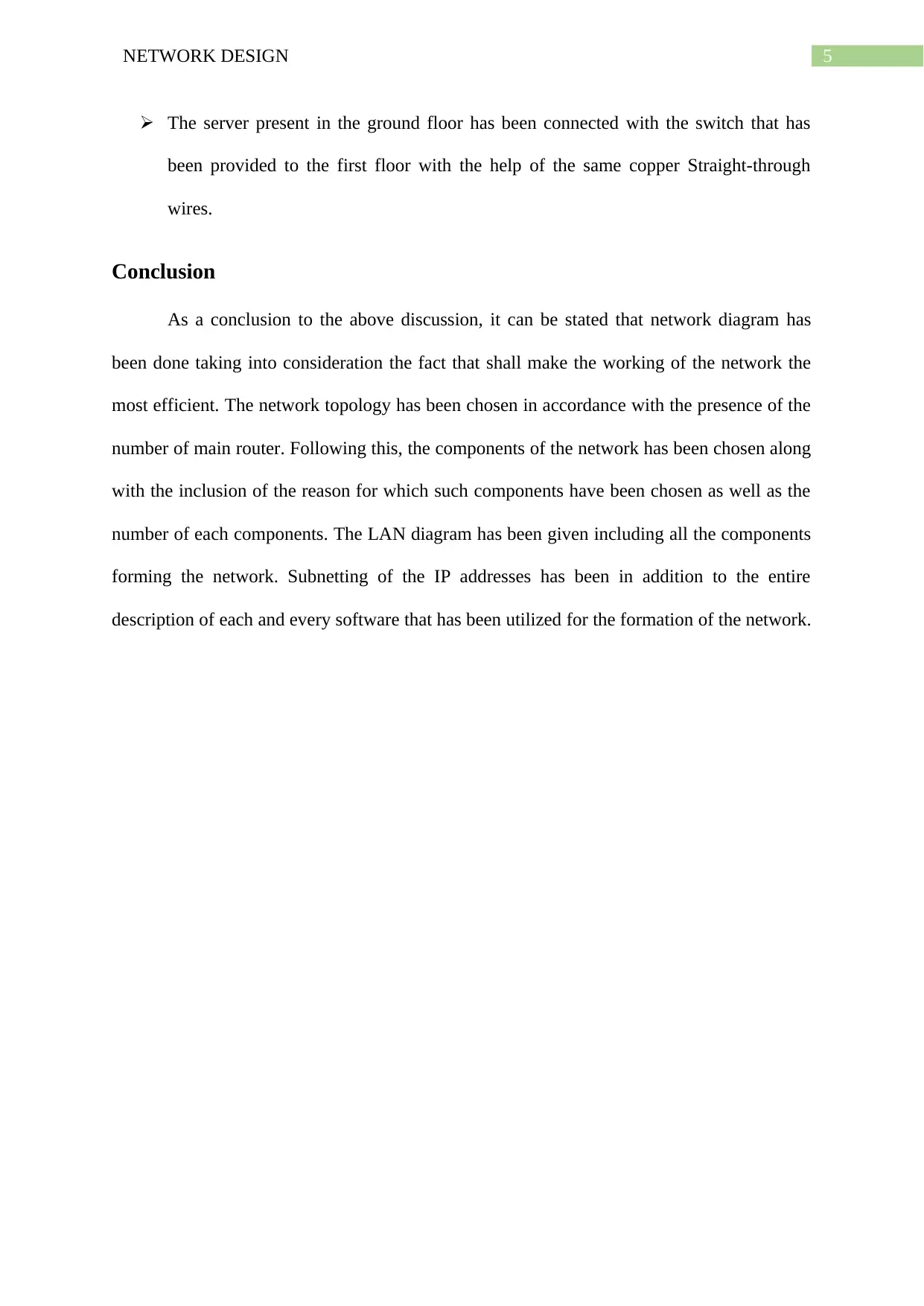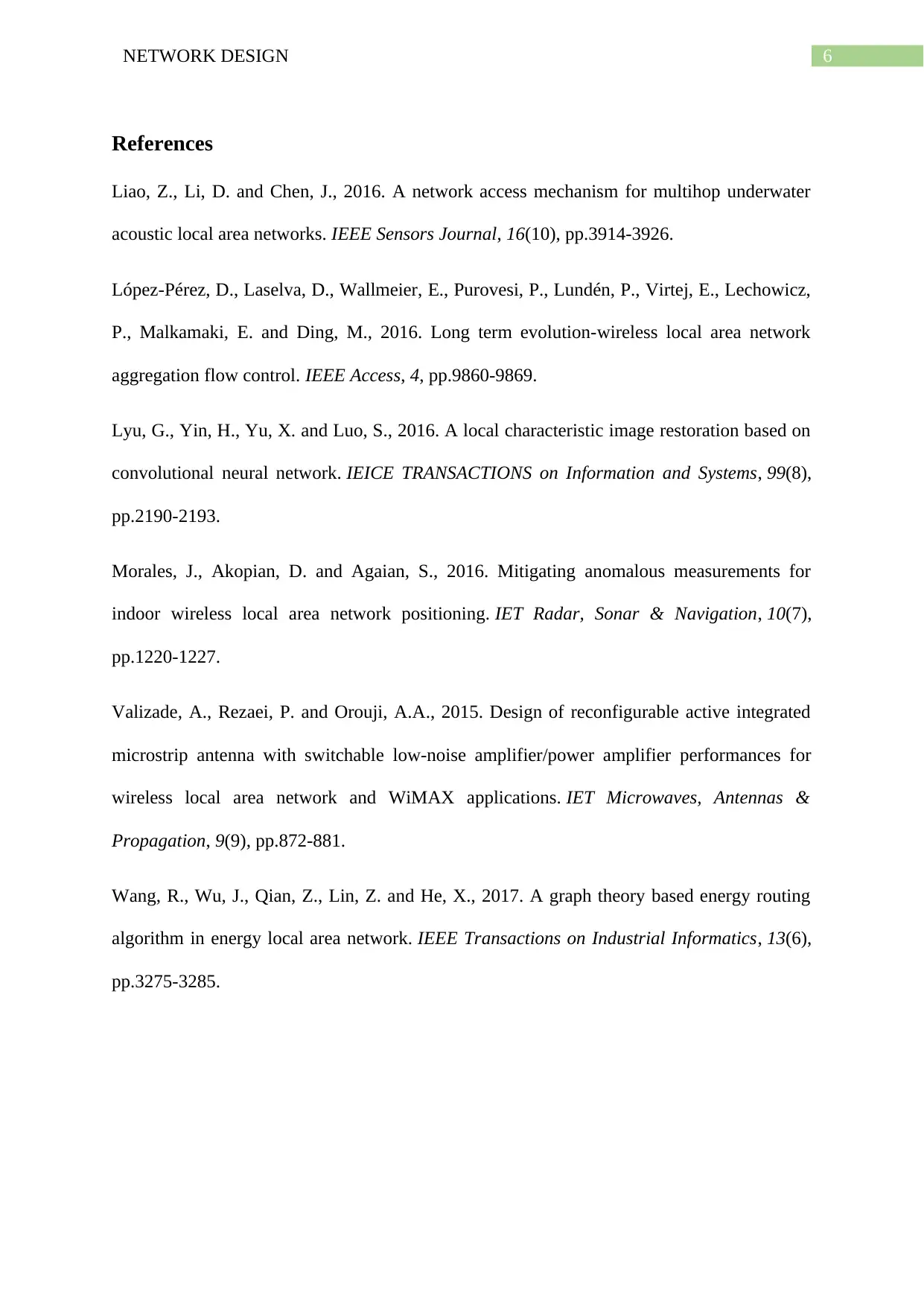Network Design Project: LAN Design for Top Class Networks
VerifiedAdded on 2022/11/07
|7
|1156
|69
Project
AI Summary
This project presents a detailed Local Area Network (LAN) design for Top Class Networks (TCN), a multi-floor organization in Sydney. The solution outlines a star topology network, with each of the five departments (Administration, Hardware, Sales, Customer Support, and Human Resources) allocated a dedicated floor, router, and switch. The ground floor houses the server room and the main router. The design includes IP addressing and subnetting, specifying the required and allocated sizes for each department, along with the address range and broadcast addresses. The hardware components are described, including the use of routers, switches, Serial DTE cables for router connections, and Copper Straight-through wires for connecting routers to switches and workstations. The project concludes with a summary of the design choices and references to related research.

Running head: NETWORK DESIGN
NETWORK DESIGN
Name of the Student:
Name of the University:
Author Note:
NETWORK DESIGN
Name of the Student:
Name of the University:
Author Note:
Paraphrase This Document
Need a fresh take? Get an instant paraphrase of this document with our AI Paraphraser

1NETWORK DESIGN
Table of Contents
Introduction................................................................................................................................2
Design and Description of the Local Area Network..................................................................2
Network Topology.................................................................................................................2
LAN Design...........................................................................................................................3
IP Addresses...........................................................................................................................3
Description of the hardware.......................................................................................................4
Conclusion..................................................................................................................................5
References..................................................................................................................................6
Table of Contents
Introduction................................................................................................................................2
Design and Description of the Local Area Network..................................................................2
Network Topology.................................................................................................................2
LAN Design...........................................................................................................................3
IP Addresses...........................................................................................................................3
Description of the hardware.......................................................................................................4
Conclusion..................................................................................................................................5
References..................................................................................................................................6

2NETWORK DESIGN
Introduction
The Top Class Networks (TCN) that is located in Sydney has an entire building
consisting of five floors in total dedicated to this organization to be specific. The company
has been divided into five main departments namely, Administration, Hardware, Sales,
Customer Support and lastly, Human Resource. Every single department has been allotted a
different floor. The first floor has been given to the Administration department, the second
floor belongs to the Customer Support, Hardware department has been situated in the third
floor (López-Pérez et al., 2016). The fourth floor is dedicated to the Human Resource and
lastly, the Sales department is on the fifth floor.
As an approach towards the development of a network within the organization, every
single department shall be supplied with a specific router along with that of a switch. Along
with this, the ground floor which is the server room has a separate router for itself as well as
consists of the main router to which every single of the six routers shall be connected (Wang
et al., 2017). In addition to this, the workstations belonging to every department shall be
connected with the routers through the switches that are present.
Design and Description of the Local Area Network
Network Topology
The network topology selected for this particular network is star topology. In star
topology, there is the presence of a main router in the middle to which all of the routers shall
be connected (Morales, Akopian and Agaian, 2016). In this network, there is no need of any
connection between the individual routers that are present on each floor, hence the star
topology has been chosen for the building of this network.
Introduction
The Top Class Networks (TCN) that is located in Sydney has an entire building
consisting of five floors in total dedicated to this organization to be specific. The company
has been divided into five main departments namely, Administration, Hardware, Sales,
Customer Support and lastly, Human Resource. Every single department has been allotted a
different floor. The first floor has been given to the Administration department, the second
floor belongs to the Customer Support, Hardware department has been situated in the third
floor (López-Pérez et al., 2016). The fourth floor is dedicated to the Human Resource and
lastly, the Sales department is on the fifth floor.
As an approach towards the development of a network within the organization, every
single department shall be supplied with a specific router along with that of a switch. Along
with this, the ground floor which is the server room has a separate router for itself as well as
consists of the main router to which every single of the six routers shall be connected (Wang
et al., 2017). In addition to this, the workstations belonging to every department shall be
connected with the routers through the switches that are present.
Design and Description of the Local Area Network
Network Topology
The network topology selected for this particular network is star topology. In star
topology, there is the presence of a main router in the middle to which all of the routers shall
be connected (Morales, Akopian and Agaian, 2016). In this network, there is no need of any
connection between the individual routers that are present on each floor, hence the star
topology has been chosen for the building of this network.
⊘ This is a preview!⊘
Do you want full access?
Subscribe today to unlock all pages.

Trusted by 1+ million students worldwide

3NETWORK DESIGN
LAN Design
Figure-1: Local Area Network Design
(Source- Created by Author)
IP Addresses
Subnet Name Neede
d Size
Allocate
d Size Address Mas
k Dec Mask Assignab
le Range
Broadca
st
Sales 38 62 10.0.0.0 /26 255.255.255.1
92
10.0.0.1 -
10.0.0.62 10.0.0.63
HR 33 62 10.0.0.64 /26 255.255.255.1
92
10.0.0.65
-
10.0.0.12
6
10.0.0.12
7
Customer
Support 28 30 10.0.0.12
8 /27 255.255.255.2
24
10.0.0.12
9 -
10.0.0.15
8
10.0.0.15
9
Hardware 23 30 10.0.0.16
0 /27 255.255.255.2
24
10.0.0.16
1 -
10.0.0.19
0
10.0.0.19
1
Admininstrati
on 8 14 10.0.0.19
2 /28 255.255.255.2
40
10.0.0.19
3 -
10.0.0.20
6
10.0.0.20
7
Ground Floor 1 2 10.0.0.23
2
/30 255.255.255.2
52
10.0.0.23
3 -
10.0.0.23
5
LAN Design
Figure-1: Local Area Network Design
(Source- Created by Author)
IP Addresses
Subnet Name Neede
d Size
Allocate
d Size Address Mas
k Dec Mask Assignab
le Range
Broadca
st
Sales 38 62 10.0.0.0 /26 255.255.255.1
92
10.0.0.1 -
10.0.0.62 10.0.0.63
HR 33 62 10.0.0.64 /26 255.255.255.1
92
10.0.0.65
-
10.0.0.12
6
10.0.0.12
7
Customer
Support 28 30 10.0.0.12
8 /27 255.255.255.2
24
10.0.0.12
9 -
10.0.0.15
8
10.0.0.15
9
Hardware 23 30 10.0.0.16
0 /27 255.255.255.2
24
10.0.0.16
1 -
10.0.0.19
0
10.0.0.19
1
Admininstrati
on 8 14 10.0.0.19
2 /28 255.255.255.2
40
10.0.0.19
3 -
10.0.0.20
6
10.0.0.20
7
Ground Floor 1 2 10.0.0.23
2
/30 255.255.255.2
52
10.0.0.23
3 -
10.0.0.23
5
Paraphrase This Document
Need a fresh take? Get an instant paraphrase of this document with our AI Paraphraser

4NETWORK DESIGN
10.0.0.23
4
Description of the hardware
The hardware that has been for the setting up of this local area network has been
described below in brief (Lyu et al., 2016). These are,
Every single department has been provided with a single router along with that of a
switch dedicatedly serving every single floor of the five - floor building belonging to
the Top Class Network (TCN) organization.
The ground floor, which has been referred to as the server room has been provided
with the server. This also consists of a separate switch.
Each of the routers have been connected with that of the main router with the help of
Serial DTE wires (Valizade, Rezaei and Orouji, 2015). Serial DTE cables have been
utilized specifically for this connections since, these cables provision with a better
shielding as well as an enhanced way of connection with much faster communication
getting carried out.
All of the routers have been connected to the switch before the switch again forms a
specific connection with all the workstations present within the departments
separately.
Connection of the routers to the switches and again the workstations to the switches
have been done with the help of Copper Straight-through wires (Liao, Li and Chen,
2016). Copper straight-through wires have been used for an enhanced connection
between the communication getting carried out within the switch and the workstations
that are present within the network.
10.0.0.23
4
Description of the hardware
The hardware that has been for the setting up of this local area network has been
described below in brief (Lyu et al., 2016). These are,
Every single department has been provided with a single router along with that of a
switch dedicatedly serving every single floor of the five - floor building belonging to
the Top Class Network (TCN) organization.
The ground floor, which has been referred to as the server room has been provided
with the server. This also consists of a separate switch.
Each of the routers have been connected with that of the main router with the help of
Serial DTE wires (Valizade, Rezaei and Orouji, 2015). Serial DTE cables have been
utilized specifically for this connections since, these cables provision with a better
shielding as well as an enhanced way of connection with much faster communication
getting carried out.
All of the routers have been connected to the switch before the switch again forms a
specific connection with all the workstations present within the departments
separately.
Connection of the routers to the switches and again the workstations to the switches
have been done with the help of Copper Straight-through wires (Liao, Li and Chen,
2016). Copper straight-through wires have been used for an enhanced connection
between the communication getting carried out within the switch and the workstations
that are present within the network.

5NETWORK DESIGN
The server present in the ground floor has been connected with the switch that has
been provided to the first floor with the help of the same copper Straight-through
wires.
Conclusion
As a conclusion to the above discussion, it can be stated that network diagram has
been done taking into consideration the fact that shall make the working of the network the
most efficient. The network topology has been chosen in accordance with the presence of the
number of main router. Following this, the components of the network has been chosen along
with the inclusion of the reason for which such components have been chosen as well as the
number of each components. The LAN diagram has been given including all the components
forming the network. Subnetting of the IP addresses has been in addition to the entire
description of each and every software that has been utilized for the formation of the network.
The server present in the ground floor has been connected with the switch that has
been provided to the first floor with the help of the same copper Straight-through
wires.
Conclusion
As a conclusion to the above discussion, it can be stated that network diagram has
been done taking into consideration the fact that shall make the working of the network the
most efficient. The network topology has been chosen in accordance with the presence of the
number of main router. Following this, the components of the network has been chosen along
with the inclusion of the reason for which such components have been chosen as well as the
number of each components. The LAN diagram has been given including all the components
forming the network. Subnetting of the IP addresses has been in addition to the entire
description of each and every software that has been utilized for the formation of the network.
⊘ This is a preview!⊘
Do you want full access?
Subscribe today to unlock all pages.

Trusted by 1+ million students worldwide

6NETWORK DESIGN
References
Liao, Z., Li, D. and Chen, J., 2016. A network access mechanism for multihop underwater
acoustic local area networks. IEEE Sensors Journal, 16(10), pp.3914-3926.
López-Pérez, D., Laselva, D., Wallmeier, E., Purovesi, P., Lundén, P., Virtej, E., Lechowicz,
P., Malkamaki, E. and Ding, M., 2016. Long term evolution-wireless local area network
aggregation flow control. IEEE Access, 4, pp.9860-9869.
Lyu, G., Yin, H., Yu, X. and Luo, S., 2016. A local characteristic image restoration based on
convolutional neural network. IEICE TRANSACTIONS on Information and Systems, 99(8),
pp.2190-2193.
Morales, J., Akopian, D. and Agaian, S., 2016. Mitigating anomalous measurements for
indoor wireless local area network positioning. IET Radar, Sonar & Navigation, 10(7),
pp.1220-1227.
Valizade, A., Rezaei, P. and Orouji, A.A., 2015. Design of reconfigurable active integrated
microstrip antenna with switchable low-noise amplifier/power amplifier performances for
wireless local area network and WiMAX applications. IET Microwaves, Antennas &
Propagation, 9(9), pp.872-881.
Wang, R., Wu, J., Qian, Z., Lin, Z. and He, X., 2017. A graph theory based energy routing
algorithm in energy local area network. IEEE Transactions on Industrial Informatics, 13(6),
pp.3275-3285.
References
Liao, Z., Li, D. and Chen, J., 2016. A network access mechanism for multihop underwater
acoustic local area networks. IEEE Sensors Journal, 16(10), pp.3914-3926.
López-Pérez, D., Laselva, D., Wallmeier, E., Purovesi, P., Lundén, P., Virtej, E., Lechowicz,
P., Malkamaki, E. and Ding, M., 2016. Long term evolution-wireless local area network
aggregation flow control. IEEE Access, 4, pp.9860-9869.
Lyu, G., Yin, H., Yu, X. and Luo, S., 2016. A local characteristic image restoration based on
convolutional neural network. IEICE TRANSACTIONS on Information and Systems, 99(8),
pp.2190-2193.
Morales, J., Akopian, D. and Agaian, S., 2016. Mitigating anomalous measurements for
indoor wireless local area network positioning. IET Radar, Sonar & Navigation, 10(7),
pp.1220-1227.
Valizade, A., Rezaei, P. and Orouji, A.A., 2015. Design of reconfigurable active integrated
microstrip antenna with switchable low-noise amplifier/power amplifier performances for
wireless local area network and WiMAX applications. IET Microwaves, Antennas &
Propagation, 9(9), pp.872-881.
Wang, R., Wu, J., Qian, Z., Lin, Z. and He, X., 2017. A graph theory based energy routing
algorithm in energy local area network. IEEE Transactions on Industrial Informatics, 13(6),
pp.3275-3285.
1 out of 7
Related Documents
Your All-in-One AI-Powered Toolkit for Academic Success.
+13062052269
info@desklib.com
Available 24*7 on WhatsApp / Email
![[object Object]](/_next/static/media/star-bottom.7253800d.svg)
Unlock your academic potential
Copyright © 2020–2025 A2Z Services. All Rights Reserved. Developed and managed by ZUCOL.





